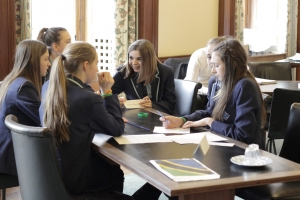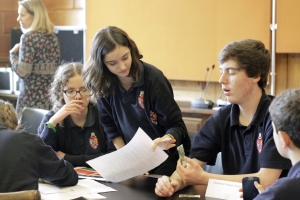 We are surrounded by media in lots of different forms, whether it’s through the old style print media like newspapers or magazines, or websites, or social media. They are all written with a certain viewpoint. Every piece of writing has been written with a different agenda and a select audience in mind. In our ever changing and fast moving world we need to learn the skills to access, analyse, evaluate and create media in all its forms so we can gather a balanced view of the world around us and what is happening. This page will help teachers educate about media literacy, using examples from the waste industry, including subjects around the plastic pollution problem and other recent issues.
We are surrounded by media in lots of different forms, whether it’s through the old style print media like newspapers or magazines, or websites, or social media. They are all written with a certain viewpoint. Every piece of writing has been written with a different agenda and a select audience in mind. In our ever changing and fast moving world we need to learn the skills to access, analyse, evaluate and create media in all its forms so we can gather a balanced view of the world around us and what is happening. This page will help teachers educate about media literacy, using examples from the waste industry, including subjects around the plastic pollution problem and other recent issues.
The information on this page can also be downloaded as a separate sheet.
Four Principles of Digital Literacy:
There are four main principles of digital media literacy. When looking at items online it will help to consider these things:
Comprehension
What is the article about? Can you understand the message, both explicit (what is written about) and implicit (what message is conveyed/implied but left unsaid)? What is the purpose of the article/video/picture/video/meme?
Interdependence
All digital media relates to another form of media somehow. What is the source of the article/video/picture/video/meme? Who made it? Where is the information contained in it from? Is it a reputable and verifiable source?
Social Factors
Sharing and passing on the message is critical in our everyday interactions with digital media. Who shared this with you? Was this suggested to you because of something else you clicked on? Who will you share it with? (THINK BEFORE YOU CLICK!)
Curation
Choosing what we like has taken on new meaning in our online lives. We need an awareness of where information has come from and who might have curated it for us to read or discover. How is this article/video/picture/video/meme stored and collected?
Questions to ask about media:
It is easy to be fooled by websites, posts or other online media. Use the prompts below to help decipher and decode what different websites or social media is telling you.
Author
- Who wrote the content?
- Was it a company? Government? Individual?
- Think about their possible bias or slant on the subject.
Purpose
- Why was it written? Think about what it is saying, both explicitly (plainly) or implicitly (is there a hidden message).
- Do you trust the author?
Accuracy
- Is the information out of date?
- When was it written?
- Is it believable?
Website Design
- What does the design of the website tell you?
- Has it been made professionally?
- Are there spelling mistakes and grammatical errors?
Website Search
- Does an internet search including the words “fake” or “scam” come up with any hits?
- Is it a verified source?
- Where does the website appear in a search engine?
- What might the ranking of the website in the search engine tell you?
- Look for promotion of sponsored material or popular sites.
- Is it promoted by another company or interest group?
Fairness Test
- Does the website seem fair?
Questions to ask about images:
You can also go further with more research to understand the images that accompany posts and articles and help you decide if what you are seeing has actually happened or has been doctored to appear a certain way.
Source
- Who took the picture?
- Who published the picture?
- Government? Individual?
- Think about their possible bias or slant on the subject
- Look for the oldest or original picture
Purpose or Motive
- Why was it taken?
- Was it staged for dramatic effect?
Accuracy
- Are the images accurate?
- Have they been modified or changed in some way?
Website Search
- Perform a reverse image search to find out the history and background of an image.
Fairness Test
- Be skeptical, not cynical!
- Does the image seem a fair representation of the facts?
 Microplastics on Snowdon!
Microplastics on Snowdon!
This lesson plan will help students from Y5 to Y8 evaluate and assess some recent news stories from the waste industry, understanding what is going on and what might be happening behind the scenes when we read things online.
Download Lesson Plan on Digital Literacy: Microplastics on Snowdon
Download PowerPoint for Digital Literacy Lesson: Microplastics on Snowdon
 The Textiles Conundrum
The Textiles Conundrum
This lesson plan will help students from Y8 to Y11 evaluate and assess a contemporary waste management issue, understanding the current situation and what might be happening behind the scenes when we read stories and adverts online.
The Textile Industry is the second most polluting industry in the world. Find out more in the Ted Ed lesson here: https://ed.ted.com/on/uRCT8bE3.
Clothing and fashion companies are always trying to sell us more clothes. What can we do when we know that this is unsustainable? Some companies may also try to “greenwash” what they do, so it appears that they are following eco-conscious practices, while continuing to follow practices that cause harm to the environment. Often this means it can be hard to work out whether the company is genuinely trying to work hard to protect the environment, reduce their carbon footprint and reduce waste, or just trying to retain customers and maximise profits.
See the lesson plan below which will help older secondary age students analyse the information that is being given to them and make good choices when it comes to buying and disposing of clothes.
Download Lesson Plan on Digital Literacy: Understanding the textiles industry
Download Info and Question Cards on Digital Literacy: Understanding the textiles industry
Download PowerPoint for Digital Literacy Lesson: Understanding the textiles industry
More Information
There is loads of good quality information out there to understand what the internet and social media is trying to tell you, why you should question what you see sometimes and how to decipher and decode our ever more digital lives.
Here is a YouTube playlist of some useful information about fact checking your social media.
And a useful article about some fact-checking websites and there are also some fact-checking Twitter feeds like Factcheck.org and PolitiFact.
